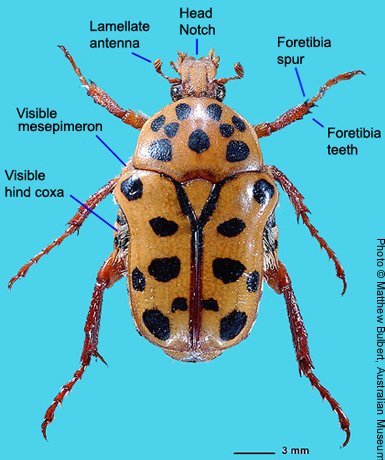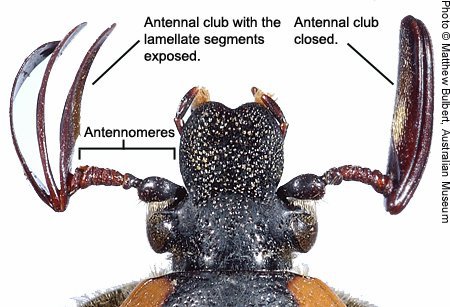
Introduction to the Australian Cetoniinae (Flower Chafers)
Identification
To identify a flower chafer three steps need to be followed:
Step 1: Identification of Coleoptera (beetles)
To determine if your insect is a beetle, go to the "Key to Insect Orders" located at the lucidcentral.org Key Server website. If it is a beetle, then the correct family, Scarabaeidae must be determined.
Step 2: Determination of the family Scarabaeidae
|
|
|
Figure 1
|

|
|
Figure 2
|

|
|
Figure 3
|
The family Scarabaeidae is large, consisting of around 2300 genera and over 27000 species worldwide (Cassis & Weir 1992). There are approximately 3000 species in Australia.
The Australian Scarabaeidae possess the following characteristics (modified from Lawrence & Britton 1994):
- head not covered by pronotum (Fig. 1)
- labrum or mandibles or both usually hidden below edge of head (Fig. 1)
- body not capable of rolling into a ball
- abdomen with 6 visible ventrites
- 3-8 segmented antennal club present and distinct (Fig. 1).
- antennal club segments strongly asymmetric, usually lamellate (Fig. 1).
- less than 11 antennal segments (Fig. 1)
- fore coxae large, occupying most of underside of prothorax
- tarsus with 5 simple, unlobed, segments (Fig. 2)
- fore tibial spur single or absent (Fig. 2).
Step 3: Identification of subfamily Cetoniinae (flower chafers)
The following features are shared by all Australian Cetoniinae (modified from Lawrence & Britton 1994):
- base of antenna visible from above (Fig. 1)
- antennae 10-segmented (Fig. 1)
- hind tarsal claws symmetrical
- fore coxae conical, produced downwards from body
- elytra without narrow membranous margin
- mesepimera almost always visible from above (Fig. 2)
- abdominal spiracles visible below edge of elytra
Classification of Cetoniinae
Flower Chafers or Flower Beetles, belong to a subfamily of Scarabaeidae known as Cetoniinae. The subfamily consists of 510 genera and 3600 species worldwide of which 30 genera and 134 species occur in Australia (Krikken 1978; Cassis and Weir 1992; Allard 1995).
Most Cetoniinae in Australia belong to the tribe Schizorhinini, which is endemic to the Australasian region. The two other tribes Cetoniini and Valgini are shared with Oriental, Holarctic and Ethiopian regions (Krikken 1984).
This key addresses species inhabiting the Australian state of New South Wales (NSW) that belong to the tribes Cetoniini and Schizorhinini only. Valgini are small (2.5-6 mm) dull coloured beetles. The taxonomy of this group is unresolved and we have been unable to identify the named species.
The Australian Cetoniinae have been revised relatively recently and their taxonomy may be considered stable (Bacchus 1974; Simpson 1990).
The species of Schizorhinini are identifiable from illustrated works (Allard 1995) but the identification of genera in this tribe is difficult. The classification of Krikken (1984; Cassis & Weir 1992) is followed here because it recognises three fewer genera than the most recent attempt (Allard 1995). However, most of the genera are still separated on trivial differences and like Lea (1914), Krikken (1984) and Allard (1995) we are unable to provide a key to them. The genera do not seem to represent biologically useful entities and far too many have only one known species (7).
Biology
Flower chafer adults are unusual amongst beetles because their elytra do not open for flight (Fig. 3). They are powerful fliers, commonly found around the canopies of blossoming trees. As their name suggests, Cetoniinae adults are generally flower-feeding, but some species may also feed on leaves and a few are more frequently found at sap flows or eating rotting fruit.
Most species occur in woodland and dry forest, rather than rainforest.
The larvae are typical white C-shaped scarab grubs, although hairier than most other scarabs. They feed on a wide range of dead or decaying vegetable matter, including rotting wood in tree hollows, compost heaps and detritus in termite nests.
Notes are provided on the biology of individual species, where available.

